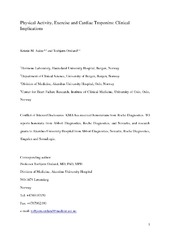| dc.contributor.author | Aakre, Kristin Moberg | en_US |
| dc.contributor.author | Omland, Torbjørn | en_US |
| dc.date.accessioned | 2020-05-12T11:26:05Z | |
| dc.date.available | 2020-05-12T11:26:05Z | |
| dc.date.issued | 2019 | |
| dc.Published | Aakre A, Omland T. Physical activity, exercise and cardiac troponins: Clinical implications. Progress in cardiovascular diseases. 2019;62(2):108-115 | eng |
| dc.identifier.issn | 1873-1740 | |
| dc.identifier.issn | 0033-0620 | |
| dc.identifier.uri | https://hdl.handle.net/1956/22199 | |
| dc.description.abstract | Cardiac troponins constitute essential components of the cardiac contractile apparatus and are released into the bloodstream following cardiomyocyte injury. Because of their cardiac specificity, cardiac troponin I or T are the recommended biomarkers for diagnosing acute myocardial infarction. However, cardiac troponin concentrations also frequently increase acutely after strenuous prolonged exercise, making the interpretation of cardiac troponin test results in patients presenting with acute chest pain challenging. This acute troponin response following exercise is commonly considered to be physiological and without adverse long-term consequences, but the possibility of exercise-induced, minor myocardial injury that may become clinically relevant if repeated over decades, has not been ruled out. Attempts to biochemically differentiate between physiological cardiac troponin release versus release after acute ischemic myocardial injury has so far proved largely unsuccessful, but future measurement of specific troponin fragments could be promising. Cardiac troponins also provide strong prognostic information across the spectrum of cardiovascular (CV) disease (CVD). In the chronic setting, low-level elevation of cardiac troponins has been associated with adverse outcome, and concentrations even within the normal range provide independent information concerning risk of developing heart failure (HF) and CVD death. Exercise exerts many beneficial effects on the CV system, and longitudinal observational data from epidemiological studies suggest that higher physical activity (PA) is associated with lower concentrations of cardiac troponins. Conversely, a sedentary life-style has been associated with higher cardiac troponin concentrations and a parallel increase in the risk of HF. Serial measurement of cardiac troponins using high sensitivity assays for monitoring the effect of life-style intervention, including PA appears promising. | en_US |
| dc.language.iso | eng | eng |
| dc.publisher | Elsevier | eng |
| dc.rights | Attribution-NonCommercial-NoDerivs CC BY-NC-ND | eng |
| dc.rights.uri | http://creativecommons.org/licenses/by-nc-nd/4.0/ | eng |
| dc.title | Physical activity, exercise and cardiac troponins: Clinical implications | en_US |
| dc.type | Peer reviewed | |
| dc.type | Journal article | |
| dc.date.updated | 2019-12-06T14:25:09Z | |
| dc.description.version | acceptedVersion | en_US |
| dc.rights.holder | Copyright 2019 Elsevier | |
| dc.identifier.doi | https://doi.org/10.1016/j.pcad.2019.02.005 | |
| dc.identifier.cristin | 1701938 | |
| dc.source.journal | Progress in cardiovascular diseases | |

